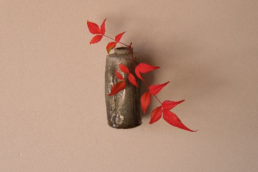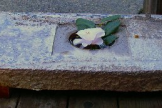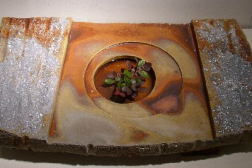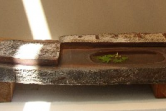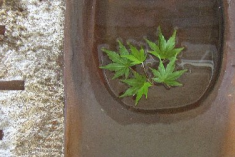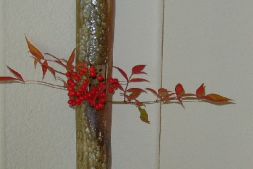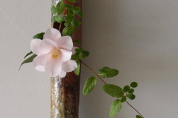Form and Function in Wood Firing – March – April 2007
Tri Tran has effectively fused Asian’s aesthetics and Western influence. His imagery is modernistic, minimalist, organic, understated, untraditional and executed in wide variations of shape, line and color. He successfully blends ambiguous imagery with functional purpose. His ultra-long wall vases and water gardens both express sculptural form and functionality. Several trips to Japan also gave him a greater appreciation and love for ceramics, especially for tea ware. Thus, he has devoted significant energy toward this ever elusive form.
His ceramics are mostly fired in an Anagama kiln, an ancient Japanese firing technique that uses wood as the source of fuel and the resulting wood ash as a glaze. The rich colors and dynamic textures derive from the merging of wood ashes, the various clays, stone compositions, and the 7 to 10 days of firing for the temperature to reach 2300 degrees. This technique yields unconventional, earthy and individualistic qualities, giving each work its own uniqueness.
The scope of his work continues to evolve and expand into many exciting forms and designs.
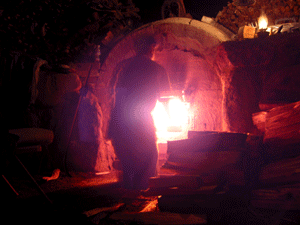 Wood-Fired Ceramic Art
Wood-Fired Ceramic Art
Wood-fired ceramics have been deeply rooted in Japan for hundreds of years. This art form embraces the concept of subtle and unobvious beauty that expresses the aesthetic principles known as wabi and sabi. There have been hundreds of written pages attempting to explain this concept of beauty. Within this context, wood-fired ceramics hope to capture textures and colors that are warm, natural, organic, subdued, modest, minimal, tranquil, unpredictable, simple yet rich in its essence and spirit.
There are many types of wood kilns. However, we focus on the process of the Anagama kiln in which we fired the works exhibited at Iwasawa Gallery.
An Anagama (a Japanese term meaning “cave kiln”) consists of a firing chamber with a firebox at one end and a flue at the other. The term Anagama describes single-chamber kilns built in a sloping tunnel shape. In fact, ancient kilns were sometimes built by digging tunnels into banks of clay.
The Anagama is fueled with firewood, in contrast to the electric or gas-fueled kilns commonly used by most contemporary ceramic artists. A continuous supply of fuel is needed for firing, as wood stoked into the hot kiln is consumed very rapidly. Stoking occurs round-the-clock for approximately 7 to 10 days until an appropriate temperature is reached and maintained as high as 2375 degrees F (1300 degrees C). Thus it is a highly labor-intensive process making it infrequent, and kiln space, being scarce, is a precious commodity.
Burning wood not only produces heat, it also produces fly ash. Wood ash settles on the pieces during the firing, and the complex interaction between flame, ash, and the minerals comprising the clay body forms a natural ash glaze. This glaze may show great variation in color, texture, and thickness ranging from smooth and glossy to rough and sharp.
